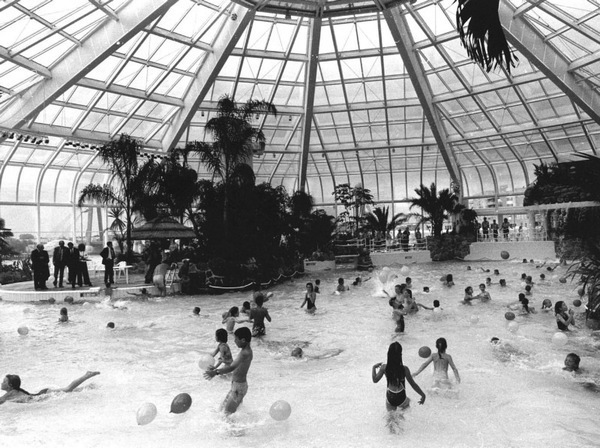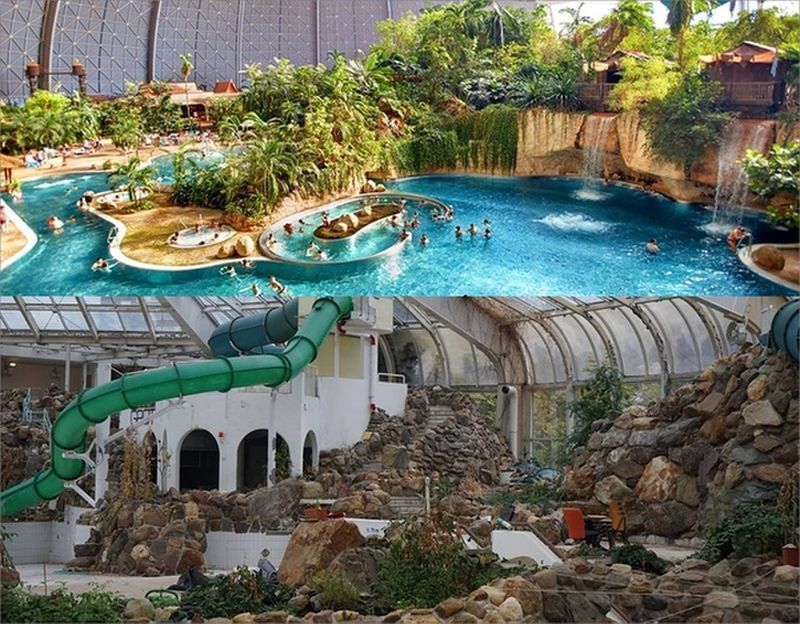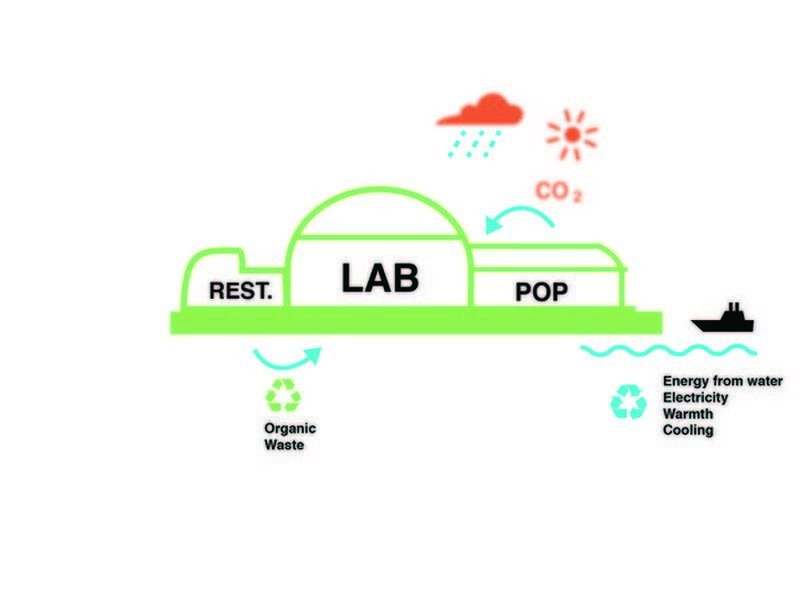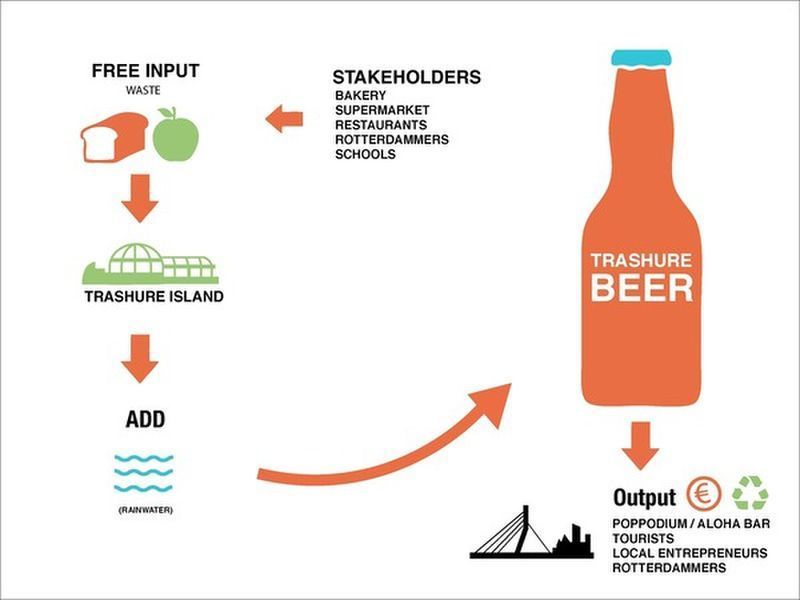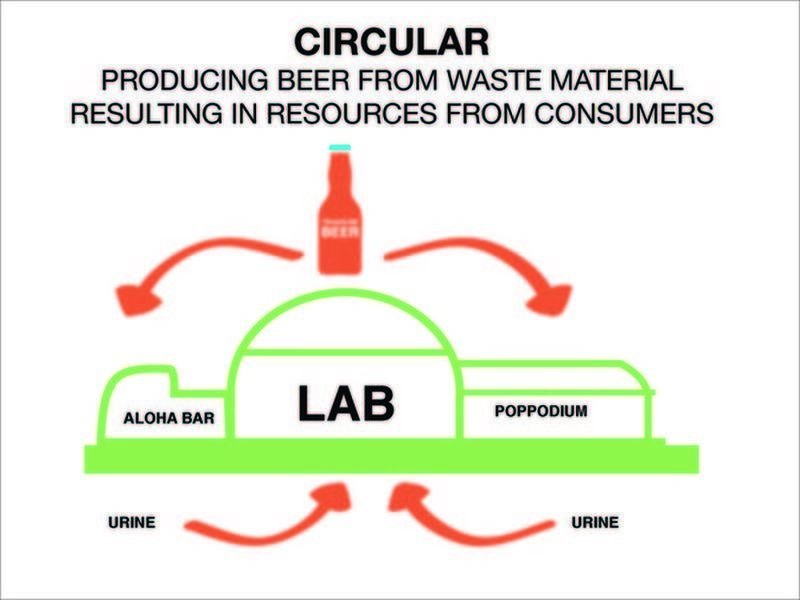Difference between revisions of "Trashure Island - a proposal for a circular economy in Tropicana"
(→Case study, Trashure beer) |
(→Case study, Trashure beer) |
||
| Line 129: | Line 129: | ||
=== Case study, Trashure beer === | === Case study, Trashure beer === | ||
| − | <youtube> | + | <youtube>1epFhxPLsf0</youtube> |
How can this ecosystem create value for the society? By addressing bad habits from individuals we can reduce waste (tangible and intangible) and increase knowledge and awareness. By surpassing dominant organizations in the industrial process and focusing on local and sustainable production. By Creating a win-win-win-win situation: cheaper, local and sustainable production in a circular economy. | How can this ecosystem create value for the society? By addressing bad habits from individuals we can reduce waste (tangible and intangible) and increase knowledge and awareness. By surpassing dominant organizations in the industrial process and focusing on local and sustainable production. By Creating a win-win-win-win situation: cheaper, local and sustainable production in a circular economy. | ||
Revision as of 16:06, 27 January 2015
Author: Students Masterclass The Circular Economy, WdKA
START IS GOED< MISSCHIEN DRASTISCH INKOTRTEN ? VERHAAL WORDT OK IN VIDEOPRESENTATIES VERTELD ? EN DAN WEL VEEL PLAATSJES + BIJDSCHRIFTEN?| IRIS
New strategies such as the Blue Economy (Gunter Pauli) and Sustainism (Michael Schwarz and Diana Krabbendam) propose solutions to ecological, economic and social crises. These movements see local materials (waste products, local communities & expertise) as valuable assets, transforming linear processes into circular processes and valuing long-term performance over short-term gain. What are working business models for such reorganisations?
Contents
- 1 Tropicana, from a dream in decay to an opportunity for change
- 2 Trashure island, the concept
- 3 Architecture
- 4 Subdivision of space
- 5 Program
- 6 Ecosystem
- 7 Re-using waste from Rotterdam
- 8 Case study, Trashure beer
- 9 What’s the problem
- 10 Who are we going to help
- 11 How can we help them
- 12 Companies
- 13 Knowledge and Education
- 14 Tourism
- 15 Business case
Tropicana, from a dream in decay to an opportunity for change
During the past century, most cities have become agglomerations of monofunctional districts which are basically disconnected from each other. Residential neighbourhoods, industrial estates, office complexes, farming districts and recreational areas are spatially delimited by administrative boundaries, making it harder to make good use of their mutual presence. The ever-increasing flow of goods, energy, water, food and even capital is disconnected form the location where these are created, contributing to endless transportation, traffic congestion, waste of energy and pollution. In a special master class at the WdKA Redesigning Business event, an interdisciplinary group of students sought ways to promote the exchange between such existing flows by making smart new connections; the main requirement of an ecosystem. The host of this master class was Rotterzwam, a local mushroom farming business which grows mushrooms on left-over coffee grounds. Their working business case was we used as a starting point for a proposal in which a building in decay is turned into a centre for innovation: sustainable, connecting and regenerative.
The masterclass took place in Tropicana, a former sub-tropical swimming paradise on the river Maas in Rotterdam that was build in 1988. It was a promise of a tropical experience, a true aquatic paradise. Due to lack of maintenance and new redevelopmentplans Tropicana had to close it's doors in the summer of 2010. Because of bankruptcy in 2011 the redevelopment into an eventshall never happened and the building fell into neglect; it became a dream in decay. At the moment this building serves as a temporary location for various businesses including a restaurant and a bar as well as facilities for roasting coffee and farming oyster mushrooms on left-over coffee grounds. Can this Rotterdam landmark become a metaphor for new ways of thinking, sharing, working and relaxing, with an important focus on recycling as well as research into flows of goods, energy, water, food and even capital? Can we make smart connections between local surpluses, shortages and bottlenecks, thus creating new functions and business cases for Tropicana?
<iframe src="http://player.vimeo.com/video/116853038" width="500" height="281" frameborder="0" webkitallowfullscreen mozallowfullscreen allowfullscreen></iframe>
Trashure island, the concept
One of the major problems in the world is waste. Wandering materials that are not absorbed back in the earths ecosystems, neither after incineration. Let´s take the tropical islands for example. When you think of tropical islands, you often imagine white beaches, a clear blue sea and lots of palm trees. However, reality is different. There is a lot of pollution because of oil industry, the production of plastics but also trash that´s being dumped into the oceans and other places around the world. All these waste problems mostly occur from the acts of the linear economy. In case of a linear economy a big amount of products are being produced to fulfill our over-consumerist needs but we do not consider thinking about these waste flows. This results in a huge plastic soup in the oceans and washed materials, which used to be treasures in a previous life. A very different picture of our tropical islands than we imagined. We, the people who produce all this waste, we are responsible for the consequences!
Rotterdam has recently been chosen as main capital of Europe, mainly because the city would like to be a leader in sustainability. Why not use Tropicana as a building that represents sustainable development and give the building the iconic status back?! Tropicana could become 'Trashure Island', an island which will share and show sustainable ideas, mainly focussing on how to reuse waste flows. This creates a circular economy. It will be an ecosystem consisting of a lab and a knowledge centre where local people can learn by doing and where innovation and experiments can take place. This way the mindset of people can be changed and will be a new kind of educating. This results in BIY: a Blue it yourself- economy. The waste flows of the the poppodium, which will soon be in the building, and the restaurant will also be a part of the circular ecosystem. This way, waste flows, trash and unemployed people become the new gold. Trash becomes treasure again. It is an innovative way of creating awareness for sustainability for the people of Rotterdam and eventually for the rest of the world. This way, people can be introduced to the blue economy in an innovative way of education.
Architecture
Trashure Island is positioned in the iconic building Tropicana. The location has many special qualities, like the positioning of the building by the Maas. The most iconic element of the building is the glass dome, turning the building into a greenhouse. Because of the vast amount of space there are opportunities for the less fortunate cultures such as housing meetings.
Because of the many possibilities with the available space this will be the ideal place to start an educational lab. The basement is very useful for producing certain types of products with remained parts of the installation of the former swimming pool. The qualities are connected on Trashure Island. If you combine all these qualities, you will get a circular ecosystem in which waist flows will be transformed into useful resources.
The height differences (as seen below) are useful when dividing the available space in areas for walking space and areas for growing products.
Subdivision of space
The area under the dome can be turned into a greenhouse and thus be made more attractive for visitors. The swimming pools could be used for production cases for plants or house water with fish that can be used as compost or food for later use elsewhere in Trashure Island. The more multi-functionality is mixed within the lab, the better a circular ecosystem could be realized. Examples of using the swimming pool are shown in the drawing.
Program
After subdivide all participants into four different groups, program group had the task to think about processes that could be placed within the concept of Trashure Island. Tropicana was once an icon and we would like to give the iconic status back in a different way.
We figured the ability of the Tropicana building was like a greenhouse, because of the dome of glass and the capability of the basement to storage and filter rainwater.
We will explain different processes and projects that we could put in the building of Tropicana. We had a few possibilities that we could apply there. First of all Trashure Island will serve as an institution with lectures, what could educate people and companies from Rotterdam. Trashure Island will become a hatchery of knowledge. • Tropicana: serve of basic need of clean water, fresh air and fertile soil.
Institution - lectures - 1:1 experiment
- Biofuel
- Algen
- Bioplastic
- Potato peelings
- Coffee grounds
- Corn
- Sugar
- (Rain)Water
- Filtering
- Plants/ food/ fish
- Energy
- Mushrooms (Rotterzwam)
- Material/food
- Packaging made of mysellium
- Moss
- Algae
- Light
- Filtering the air
- Isolation
- Energy
- Kombucha
- Leather → no chemicals needed
- Water, green tea, sugar, piece of Kombucha.
- Growing process (30 degrees)
- Cycle process/recycling
- Livestock -> eating remains after harvest instead of healthy plant
- Ecosphere
- Solar panels / windmills
- Paper made out of stone
- Excreta -> compost
- Burning the litter -> use heat
- Wood chips (normally burnt) -> growing plants
- Smart food storage
- Natural drinks
- Excreta
- Beer of potato peelings.
- Natural cleaning products
- Orange peelings
- Spider webs -> textile bulletproof skin
- Viscose (Snailpoop) textiles
- Soda cellulose
- Tropicana agriculture
- Insect cultivation
Ecosystem
An already existing concept is Aquaponics. This is a food production system that creates an ecosystem with the vision less is more. You can create a closed ecosystem where the only thing you will need is sunlight, water and air. Now in our system we have the advantage that we can use the waste of the city Rotterdam. Now you will get even more products with no costs whatsoever. For example: Beer made out of leftover bread and sugars from leftover fruits. The only thing you will have to add is water and with that you can make your own Trashure Beer.
If you have a working ecosystem the basic needs are sunlight and rainwater to produce products. We will also have the luxury to use the leftover food from companies in Rotterdam. These leftovers will be divided in two groups.
Food that is still useable will be served in the Aloha bar and you can be used for certain products. For example you can use orange peel, coffee –grounds, fruits, potato peels etc.
And the second group will be food that has started to rot witch can be used as compost for farming.
We will collect rainwater from the 10.000 m2 roof surface witch will filter and use in our products as well as for farming. Animals like chickens, fish and insects will live in our ecosystem and we can also harvest products from them.
Re-using waste from Rotterdam
Next to the ecosystem we will process waste. Such like biological waste what we will compost if it’s rotten or give a new life as meal. In this way we make treasure from trash. There are a lot of supermarkets, restaurants, school and house holdings in Rotterdam which throw away on date or damaged food. We could collect that by ‘bakfiets’ and we will process it in Tropicana. In our lab we will classify the food as edible or compostable. The meals could be served to less fortunate people and the compost will we use for growing our own vegetables / agriculture.
Case study, Trashure beer
How can this ecosystem create value for the society? By addressing bad habits from individuals we can reduce waste (tangible and intangible) and increase knowledge and awareness. By surpassing dominant organizations in the industrial process and focusing on local and sustainable production. By Creating a win-win-win-win situation: cheaper, local and sustainable production in a circular economy. For people to take responsibility of their whole company or household. By creating a knowledge center for experimentation and education. By giving people the tools to take responsibility and reduce their waste themselves.
What’s the problem
The problem is waste. We use our resources and throw away products that can be used again. There are all kinds of wastes.
- Products;
- Time;
- Talent;
- Rest-energy;
- Location.
Who are we going to help
Lots of people have a waste problem. This ecosystem will be for:
- Citizens who want to have a more sustainable lifestyle and save money in the process;
- Local citizens who are unemployed or have a low income;
- The society;
- The youth;
- Companies.
How can we help them
Tropicana will serve as a platform of regeneration.
This will be done through:
- Social events. Like tours of workshops;
- Creating Jobs;
- An open source knowledge center. Everything that’s produced here e.g. products and knowledge will be open to everyone.
The unemployed and the “less fortunate”: We will make local citizens aware of their waste problem. For example, when they are financially short at the end of the month we will give them Re- and upcycle tools to help them save money. The way they view their trash has to be turned around in seeing it as a resource. By giving them jobs throughout the whole circular production process, the time they create waste at home: in both talent, energy and in terms of resources, will be reduced.
A Possible idea: a form of ‘deposit fees’. Show them the value of their waste. To turn this into action they need proof that it really saves money. Show them a fun, easy and accessible way to do this.
Within the ecosystem there is room for initiatives by anyone who sees them.
Companies
The local companies pay to get rid of their waste. This ecosystem would like to take those waste products for free. This is an advantage for both parties. Besides that, the involvement in sustainable and blue economy activities might be good for the brand and image of these companies.
Entrepreneurs can start a business here when they have an idea that fits within the ecosystem.
Because of the advantages there could be support from the municipality. Local can get incentives to support this ecosystem, for example through tax incentives.
Knowledge and Education
A lot of things are still unknown within the bleu economy. There is a lot of room to grow. There will be room for scientists to come up and test new ideas.
The knowledge that is produced within this ecosystem will be exchanged with the outside world. Children are the future. This is why it’s so important that they will be educated about the circular and blue production process.
Knowledge will be shared through workshops and by creating a podium for discussions and debates.
Tourism
This new way of production could also attract a new kind of tourists. This eco-tourism will consists of people who love to see the idea of bleu economy in reality. In the long-term this could turn into the demand for (eco)hotels, food and souvenirs.
Business case
Everythin will come together in our business case: Tourists and companies bring income as money and get information and knowledge in return. Unemployed people give time and get knowledge in return. Schools can come so the youth can be educated. Products produced in Tropicana can be sold. A circular economy will be created within Tropicana and with its surroundings.
The participating students cam from: Bouwkunde minor dIB, Minor social practices WdKA and Cultural Economics, Erasmus University Rotterdam.
This masterclass was hosted and guided by Rotterzwam, organised by Floris Schiferli (Superuse Studios Rotterdam) and located in Tropicana, Maasboulevard 100, Rotterdam.
With special thanks to: Mark Slegers & all co-workers of Rotterzwam (host and inspirator), Rechtstreex (for the lovely local lunch), Norbert Bol (Director of Grondmij capital invest), Mark Bode (Business Station WDKA), Hans Huurman (gemeente Rotterdam), Dave Geensen, (poppodium Rotterdam).
